- Home
- Oliver Sacks
Hallucinations Page 14
Hallucinations Read online
Page 14
One such dreamscape was Chicago, where she lived as a teenager. Most of her seizures transported her to this dream Chicago—she has drawn maps of it, which contain actual landmarks, but in which the topography is strangely transformed. Other dreamscapes center around the hill in another city, where her university is situated. “For a few seconds,” she told me, “I flash back to a dream I have had, into the world of that dream, being in a different time and place. The places are ‘familiar,’ but don’t really exist.”
Another dreamscape, often reexperienced in seizures, is a transformed version of a hill town in Italy where she lived for a while. There is another, frightening one: “I’m with my little sister, on some sort of beach. We’re being bombed. And I lose her.… People are being killed.” Sometimes, she says, the dreamscapes blend together, a hill somehow turning into a beach. There are always strong emotional components—fear or excitement, usually—and these emotions can dominate her for fifteen minutes or so after the actual attack.
Laura has quite a lot of apprehension about these odd episodes. On one of her maps, she wrote, “This all really scares me. Please, help me any way possible. Thanks!” She says she would give a million dollars to be free of these attacks—but she also feels they are a portal to another form of consciousness, another time and place, another world, although that portal is not under her control.
In his 1881 Epilepsy, Gowers gave many examples of simple sensory seizures and noted that auditory warnings of a seizure were as common as visual ones. Some of his patients spoke of hearing “the sound of a drum,” “hissing,” “ringing,” “rustling,” and sometimes more complex auditory hallucinations, such as music. (Music can be a hallucination in seizures, but real music may also trigger seizures. In Musicophilia, I described several examples of such musicogenic epilepsy.)3
There may also be chewing and lip-smacking movements in a complex partial seizure, occasionally accompanied by hallucinatory tastes.4 Olfactory hallucinations, either alone as an isolated aura or as a part of complex seizure, may occur in various forms, as David Daly described in a 1958 review paper. Many of these hallucinatory smells seem unidentifiable or indescribable (except as “pleasant” or “unpleasant”), even though a patient will have the same smell in every seizure. One of Daly’s patients said his hallucinatory smell odor was “somewhat like the smell of frying meat”; another said it was “like passing a perfume shop.” One woman would experience an odor of peaches so vivid, so real, that she was certain there must be peaches in the room.5 Another patient had a “reminiscence” associated with hallucinatory smells which “seemed to recall odors in his mother’s kitchen when he was a child.”
In 1956, Robert Efron, a naval physician, provided an extraordinarily detailed description of his patient Thelma B., a middle-aged professional singer. Mrs. B. experienced olfactory symptoms in her seizures, and she also gave a striking description of what Hughlings Jackson called doubled consciousness:
I can be perfectly well in every way when suddenly I feel snatched away. I seem to feel as if I’m in two places at once but in neither place at all—it is a feeling of being remote. I can read, write and talk and can even sing my lyrics. I know exactly what is going on but I somehow don’t seem to be in my own skin.… When this feeling happens I know that I’m going to have a convulsion. I keep trying to stop it from happening. No matter what I do, it always comes. Everything goes ahead like a railroad schedule. At this part of my attack I feel very active. If I’m home I make beds, dust, sweep or do the dishes. My sister says that I do everything at breakneck speed—I rush around like a chicken with his head cut off. But to me it all seems to be in slow motion. I am very interested in the time, I’m always looking at my watch and asking someone the time every few minutes. That is why I know exactly how long this part of the attack lasts. It has been as short as ten minutes or may last the better part of a day; it is real hell then. Usually it lasts about twenty to thirty minutes. All this time I feel that I’m remote. It is like being outside a room and looking in through a keyhole, or as if I’m God just looking down on the world but not belonging to it.
At about the halfway point in her seizure, Mrs. B. said, she would get a “funny idea” in her head involving the anticipation of a smell:
I expect to smell something at any moment, but I don’t yet.… The first time it ever happened, I was out in the country and I was feeling funny. I was in a field picking forget-me-nots. I remember very well that I kept smelling these flowers even though I knew they had no odour. For about half an hour I kept sniffing them because I was sure they would begin to smell soon … even though I knew perfectly well at that time that forget-me-nots have no odour at all.… I know it and don’t know it at the same time.
In this second phase of her epileptic aura, Mrs. B. continued to feel more and more “remote,” until finally she knew a convulsion was near. She would lie on the floor, away from the furniture, to avoid hurting herself during the convulsion. Then, she said:
Just when I seem to be as remote as I possibly could get, I suddenly get a smell like an explosion or a crash. There is no buildup. It is all there at once. At the same moment that the smell crashes through, I’m back in the real world—I no longer feel remote. The smell is a disgusting sweet, penetrating odour like very cheap perfume.… Everything seems very quiet. I don’t know if I can hear. I am all alone with the smell.
The smell would last for a few seconds and then go away, though the silence remained for five or ten seconds, until she heard a voice off to her right calling her name. She said:
This is not like hearing a voice in a dream. It is a real voice. Every time I hear it I fall for it. It is not a man’s voice or a woman’s voice. I don’t recognize it. There is one thing that I do know and that is if I turn towards the voice I have a convulsion.
She would try hard not to turn towards the voice, but it was irresistible. Finally, she would lose consciousness and have a convulsion.
Gowers had a “favorite” seizure, one that he returned to in his writing many times, for this patient, like Thelma B., had an epileptic aura that involved many different sorts of hallucinations, unfolding in a “march” or stereotyped progression of symptoms. This showed Gowers how an epileptic excitation might move about the brain, stimulating first one part, then another, and evoking corresponding hallucinations as it did so. He first described this patient in his 1881 book Epilepsy:
The patient was an intelligent man, twenty-six years of age, and all his attacks began in the same manner. First there was a sensation [under the ribs, on the left side] “like pain with a cramp;” then, this sensation continuing, a kind of lump seemed to pass up the left side of the chest, with a “thump, thump,” and when it reached the upper part of the chest it became a “knocking,” which was heard as well as felt. The sensation rose up to the left ear, and then was like the “hissing of a railway engine,” and this seemed to “work over his head.” Then he suddenly and invariably saw before him an old woman in a brown-stuff dress, who offered him something which had the smell of Tonquin beans. The old woman then disappeared, and two great lights came before him—round lights, side by side, which got nearer and nearer with a jerking motion. When the lights appeared the hissing noise ceased, and he felt a choking sensation in the throat, and lost consciousness in the fit, which, from the description, was undoubtedly epileptic.
For most people, focal seizures always consist of the same symptoms repeated with little or no variation, but others may have a large repertoire of auras. Amy Tan, the novelist, whose epilepsy may have been caused by Lyme disease, described her hallucinations to me.
“When I realized the hallucinations were seizures,” she said, “I found them fascinating as brain quirks. I tried to notice the details of the ones that repeated.” And, being a writer, she gave all of her repeating hallucinations names. The most frequent one she calls the “Illuminated Spinning Odometer.” She describes it as
what you might see on the dash of your car at
night … except the numbers begin spinning more and more rapidly, like a gas pump giving you a running tally of the cost of gas. After about twenty seconds, the numbers begin to disintegrate and the odometer itself falls apart, and gradually disappears. Because it happened so often … I made it a game to see if I could name the numbers as they were falling, or to see if I could control the speed of the odometer or make the hallucination last longer. I could not.
None of her other hallucinations moved. For a time, she would often see
the figure of a woman in long white Victorian dress in the foreground of a scene with other people in the background. It looked like a faint Victorian photograph, or a black and white version of one of those Renoir paintings of people in the park.… The figure was not looking at me, not moving.… I did not mistake it as a live scene or real people. The image had no significance to anything in my life. I did not feel any heightened emotions associated with it.
She sometimes has unpleasant odor hallucinations or physical sensations, “the ground beneath me wobbling, for instance,” she says, adding, “I have to ask others if an earthquake is happening.”
She often experiences déjà vu but finds her occasional jamais vu much more disturbing:
The first time it happened, I remember looking at a building I had passed hundreds of times and thinking I had never noticed it was that color or shape, etc. And I then looked at everything around me, and none of it looked familiar. It was so disorienting I could not move an inch further. In the same way, I would sometimes not recognize my home, but I knew I was in my home. I had learned to be patient and wait for it to pass in twenty or thirty seconds.
Amy remarks that her seizures most often occur when she is waking up or dozing off. She occasionally sees “Hollywood aliens” dangling from the ceiling. They look like “someone’s inept attempt to make an alien creature for a movie set … like a spider with a Darth Vader–like helmet head.”
She emphasizes that the images have no personal relevance, are not related to anything that happened that day, and carry no special associations or emotional significance. “They do not stay in my mind as anything to think about,” she observes. “They are more like the detritus of those parts of dreams that mean nothing, like random images arbitrarily flashed in front of me.”
Stephen L., an affable, outgoing man, first consulted me in the summer of 2007. He brought with him his “neurohistory,” as he called it—seventeen pages of single-spaced typing—adding that he had “a little graphomania.” He said his problems started after an accident thirty years before, when his car was broadsided by another, and his head slammed against the windshield. He suffered a severe concussion but seemed to recover fully after a few days. Two months later, he started to have brief attacks of déjà vu: he would suddenly feel that whatever he was experiencing, doing, thinking, or feeling he had already experienced, done, thought, or felt before. At first he was intrigued by these brief convictions of familiarity and found them pleasant (“like the breeze going past my face”), but within a few weeks he was getting them thirty or forty times a day. On one occasion, to prove that the feeling of familiarity was an illusion, he stamped his foot, threw one leg high in the air, and did a sort of Highland fling in front of a washroom mirror. He knew he had never done such a thing before, but it felt as though he were repeating something he had done many times.
His attacks became not only more frequent but more complex, the déjà vu being only the start of a “cascade” (as he put it) of other experiences, which, once started, would move forward irresistibly. The déjà vu would be followed by a sharp icy or burning pain in the chest, then by an alteration of hearing, so that sounds become louder, more resonant, seemed to reverberate all around him. He might hear a song as clearly as if it were being sung in the next room, and what he heard would always be a specific performance of the song—for example, a particular Neil Young song (“After the Gold Rush”) exactly as he had heard it during a concert at his college the year before. He might then go on to experience “a bland, pungent smell” and a taste “which corresponded with the smell.”
On one occasion Stephen dreamt he was having one of his aura cascades and woke to find that he was indeed in the midst of one. But then to the usual cascade was added a strange out-of-body experience, in which he seemed to be looking down at his body as it lay in bed, through an elevated open window. This out-of-body experience seemed real—and very frightening. Frightening, in part, because it suggested to him that more and more of his brain was being involved in his seizures, and that things were getting out of control.
Nonetheless, he kept these attacks to himself until Christmas of 1976, when he had a convulsion, a grand mal seizure; he was in bed with a girl at the time, and she described it to him. He consulted a neurologist, who confirmed that he had temporal lobe epilepsy, probably caused by injury to the right temporal lobe sustained during the car crash. He was put on antiepileptics—first one, then others—but he continued to have temporal lobe seizures almost daily and two or more grand mal seizures a month. Finally, after thirteen years of trying different antiepileptic medications, Stephen consulted another neurologist for evaluation and consideration of possible surgery.
In 1990, Stephen had surgery to remove an epileptic focus in his right temporal lobe, and he felt so much better after the surgery that he decided to wean himself off medication. Then, unfortunately, he had another car accident, after which his seizures returned. These were not responsive to medication, and he had to have much more extensive brain surgery in 1997. Nevertheless, he continues to need antiepileptic medication and to have various seizure symptoms.
Stephen feels that there has been a “metamorphosis” in his personality since the start of his seizures, that he has become “more spiritual, more creative, more artistic”—specifically, he wonders whether “the right side” of his brain (as he puts it) is being stimulated, coming to dominate him. In particular, music has assumed greater and greater importance for him. He had taken up the harmonica in his college days, and now, in his fifties, he plays “obsessively,” for hours. He often writes or draws for hours at a time, too. He feels that his personality has become “all or none”—he may be either hyperfocused or completely distracted. He has also developed a tendency to sudden rage: on one occasion, when a car cut him off, he attacked the offender physically, hurling a can at his car, then punching him. (He wonders, in retrospect, whether some seizure activity played a part in this.) Despite all his problems, Stephen L. is able to continue working in medical research, and he remains an engaging, sensitive, and creative person.
There was little that Gowers or his contemporaries could do for patients with complex or focal seizures, other than giving them sedative drugs like bromides. Many patients with epilepsy, especially temporal lobe epilepsy, were considered to be “medically intractable” until the introduction of the first specific antiepileptic drug in the 1930s—and even then the most severely affected patients could not be helped. But the 1930s also saw a much more radical, surgical approach, undertaken by Wilder Penfield, a brilliant young American neurosurgeon working in Montreal, and his colleague Herbert Jasper. In order to remove the epileptic focus in the cerebral cortex, Penfield and Jasper first had to find it by mapping the patient’s temporal lobe, and this required the patient to be fully conscious. (Local anesthesia is used when opening the skull, but the brain itself is insensitive to touch and pain.) Over a twenty-year period, the “Montreal procedure” was carried out in more than five hundred patients with temporal lobe epilepsy. These people had very diverse seizure symptoms, but forty or so of them had what Penfield termed “experiential seizures,” in which, seemingly, a fixed and vivid memory of the past would suddenly burst into the mind with hallucinatory force, causing a doubling of consciousness: a patient would feel equally that he was in the operating room in Montreal and that he was, say, riding horseback in a forest. By systematically going over the surface of the exposed temporal cortex with his electrodes, Pe
nfield was able to find particular cortical points in each patient where stimulation caused a sudden, involuntary recall—an experiential seizure.6 Removal of these points could prevent further such seizures, without affecting the memory itself.
Penfield described many examples of experiential seizures:
At operation it is usually quite clear that the evoked experiential response is a random reproduction of whatever composed the stream of consciousness during some interval of the patient’s past life.… It may have been a time of listening to music, a time of looking in at the door of a dance hall, a time of imagining the action of robbers from a comic strip … a time of lying in the delivery room at birth, a time of being frightened by a menacing man, a time of watching people enter the room with snow on their clothes.… It may have been a time of standing on the corner of Jacob and Washington, South Bend, Indiana.
Penfield’s notion of actual memories or experiences being reactivated has been disputed. We now know that memories are not fixed or frozen, like Proust’s jars of preserves in a larder, but are transformed, disassembled, reassembled, and recategorized with every act of recollection.7
And yet, some memories do, seemingly, remain vivid, minutely detailed, and relatively fixed throughout life. This is especially so with traumatic memories or memories carrying an intense emotional charge and significance. Penfield was at pains, however, to emphasize that epileptic flashbacks seem to lack any such special qualities.8 “It would be very difficult to imagine,” he wrote, “that some of the trivial incidents and songs recalled during stimulation or epileptic discharge could have any possible emotional significance to the patient, even if one is acutely aware of this possibility.” He felt that the flashbacks consisted of “random” segments of experience, fortuitously associated with a seizure focus.
Curiously, though Penfield described such a variety of experiential hallucinations, he made no reference to what we now call “ecstatic” seizures—seizures that produce feelings of ecstasy or transcendent joy, such as Dostoevsky described. Dostoevsky’s seizures started in childhood, but they became frequent only in his forties, after his return from exile in Siberia. In his occasional grand mal attacks, he would emit (his wife wrote) “a fearful cry, a cry that had nothing human about it,” and then fall to the floor, unconscious. Many of these attacks were preceded by a remarkable mystical or ecstatic aura—but sometimes there would be only the aura, without any subsequent convulsions or lack of consciousness. The first occurred one Easter Eve, as his friend Sophia Kowalewski wrote in her Childhood Recollections (Alajouanine quotes this in his paper on Dostoevsky’s epilepsy). Dostoevsky was talking with two friends about religion when a bell started to toll midnight. Suddenly he exclaimed, “God exists, He exists!” He later went into detail about the experience:

 Uncle Tungsten
Uncle Tungsten Oaxaca Journal
Oaxaca Journal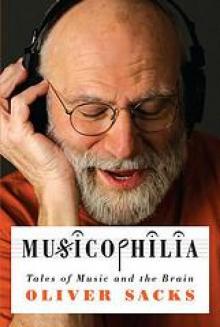 Musicophilia
Musicophilia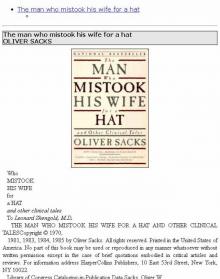 The man who mistook his wife for a hat
The man who mistook his wife for a hat 1989 - Seeing Voices
1989 - Seeing Voices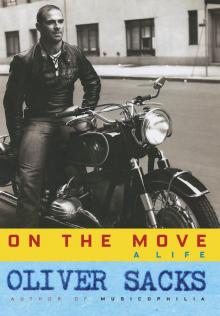 On the Move: A Life
On the Move: A Life 1996 - The Island of the Colorblind
1996 - The Island of the Colorblind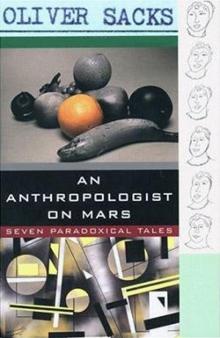 An Anthropologist on Mars: Seven Paradoxical Tales
An Anthropologist on Mars: Seven Paradoxical Tales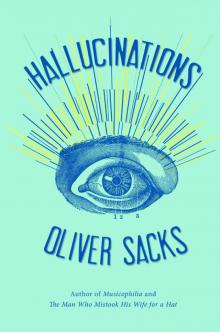 Hallucinations
Hallucinations Seeing Voices
Seeing Voices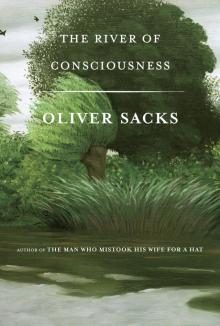 The River of Consciousness
The River of Consciousness Vintage Sacks
Vintage Sacks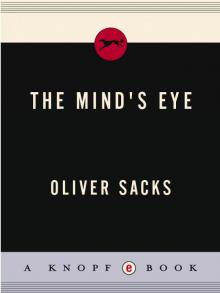 The Mind's Eye
The Mind's Eye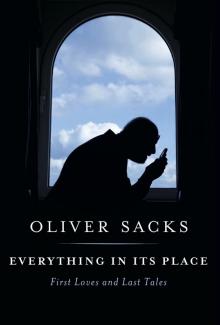 Everything in Its Place
Everything in Its Place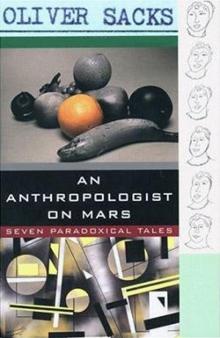 An Anthropologist on Mars (1995)
An Anthropologist on Mars (1995) Uncle Tungsten: Memories of a Chemical Boyhood (2001)
Uncle Tungsten: Memories of a Chemical Boyhood (2001)